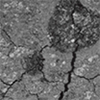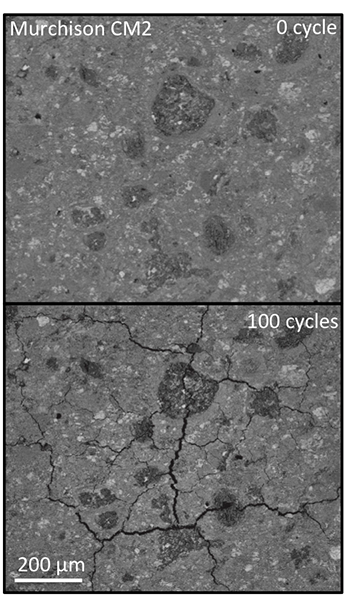 Université de la Côte d’Azur, the Observatoire de la Côte d'Azur, the CNRS and the Laboratoire Énergies & Mécanique Théorique et Appliquée et l’Institut Jean Lamour of Université de Lorraine, conducted a study on the crack code of asteroid rocks published on December 1st, 2020 in Monthly Notices of the Royal Astronomical Society.
Université de la Côte d’Azur, the Observatoire de la Côte d'Azur, the CNRS and the Laboratoire Énergies & Mécanique Théorique et Appliquée et l’Institut Jean Lamour of Université de Lorraine, conducted a study on the crack code of asteroid rocks published on December 1st, 2020 in Monthly Notices of the Royal Astronomical Society.
 A French scientific team has shown, from laser thermal cycling experiments on primitive meteorites, that the development of a cracking network on their surface depends on the amplitude of the thermal cycles imposed, the nature of the hydrated phases of the meteorites, their modal abundance and dehydration and/or dehydroxylation reactions. For CM-type carbonaceous chondrites, subjected to temperature cycles of amplitude similar to those encountered by asteroids at minimum distances to the Sun, such as near-Earth asteroids, the depth of cracks can reach a few hundred microns in a few hundred temperature cycles, increasing significantly surface and sub-surface porosity of the samples and their damage. Extrapolating this process of their million-year evolutions could help explaining the recent finding of the very highly porous surfaces of most of the boulders observed on the asteroids Ryugu and Bennu by the Hayabusa2 (JAXA) and OSIRIS-REx (NASA) mission, respectively.
A French scientific team has shown, from laser thermal cycling experiments on primitive meteorites, that the development of a cracking network on their surface depends on the amplitude of the thermal cycles imposed, the nature of the hydrated phases of the meteorites, their modal abundance and dehydration and/or dehydroxylation reactions. For CM-type carbonaceous chondrites, subjected to temperature cycles of amplitude similar to those encountered by asteroids at minimum distances to the Sun, such as near-Earth asteroids, the depth of cracks can reach a few hundred microns in a few hundred temperature cycles, increasing significantly surface and sub-surface porosity of the samples and their damage. Extrapolating this process of their million-year evolutions could help explaining the recent finding of the very highly porous surfaces of most of the boulders observed on the asteroids Ryugu and Bennu by the Hayabusa2 (JAXA) and OSIRIS-REx (NASA) mission, respectively.
Figure caption : Scanning electron microscope backscattered electron microscope images of the surface of Murchison (CM2) before (0 cycle) and after 100 thermal cycles ( ∆T ≈ 280 K and Tmax.≈ 583 K). Note the significant cracking of the surface after 100 cycles in response to the abundance of hydrated phases of the meteorite.
© Libourel et al. MNRAS (2020)
Bibliographie
Network of thermal cracks in meteorites due to temperature variations: new experimental evidences and implications for asteroid surfaces.
Guy Libourel, Clement Ganino, Marco Delbo, Mathieu Niezgoda, Benjamin Remy, Lionel Aranda, and Patrick Michel.
Monthly Notices of the Royal Astronomical Society, 1st décembre 2020
Contacts
Guy Libourel, Université Côte d’Azur, Observatoire de la Côté d’Azur, UMR Lagrange, (CNRS-UCA-OCA) - libou@oca.eu
Benjamin Remy, Laboratoire Énergies & Mécanique Théorique et Appliquée, Université de Lorraine, Nancy - benjamin.remy@univ-lorraine.fr






